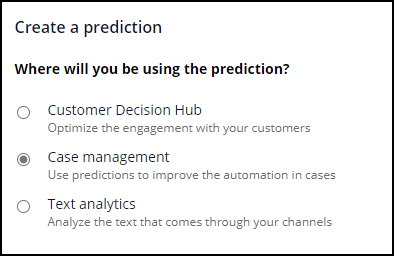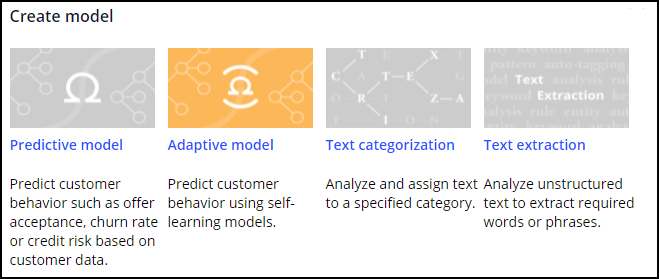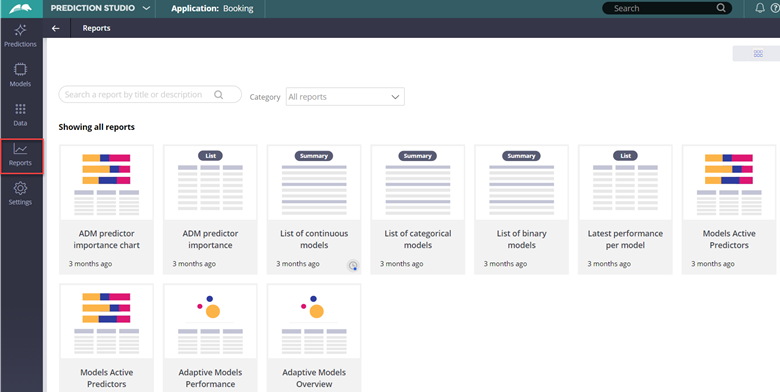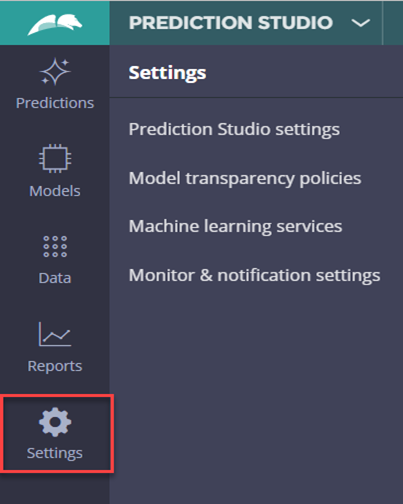
Prediction Studio overview
Artificial Intelligence (AI) and automated decisioning in Pega Platform™ are fundamental elements of Pega's Center-out™ business architecture. Lead System Architects (LSAs) need to be aware of these features and understand what constitutes the centrally managed 'brain' in Pega applications. Ideally, LSAs should be familiar with decisioning functionality and terminology.
Prediction Studio is an authoring environment in which you can control the life cycle of AI and machine learning models (such as model building, monitoring, and updates). In Prediction Studio you can also manage additional resources, such as data sets, taxonomies, and sentiment lexicons.
Adding the pxPredictionStudio portal to your access group enables you to access Prediction Studio. However, to actually work in Prediction Studio, you also need to add the appropriate work role.
Prediction Studio has five work areas: Predictions, Models, Data, Reports, and Settings. The workspace provides data scientists with everything they need to author, deploy, govern, monitor, and change AI models.
Work areas in Prediction Studio
Predictions
The Predictions landing page is used to manage or create predictions. New predictions can be one of three types, as shown in the following image. For example, you can use the Case management prediction in the Case life cycle for decision making. Predictions are driven by models.
Model
The Model landing page defines the predictive, adaptive, text categorization, and text extraction models. You use models to make predictions. After you create them, models can be self-learning - these models are included in decision strategies to fulfill customer needs and achieve business goals. The following figure shows the view:
Data
You use the Data work area to define data sets, resources, and historical data. All of the work areas are accessed from the navigation pane of Prediction Studio, as in the following figure:
In the work area, you define collections of records. A collection can be built from various sources and formats. For example, a data set instance can be sourced from a database table, stream services, or even social media sources like Twitter or YouTube. After configuring a data set, you can read, insert, and remove its records through data management operations.
Data sets are referenced in data flows and are mostly used in Pega Customer Decision Hub™ applications. Data sets can be run programmatically using the DataSet-Execute method in an activity.
In the work area, you can access resources such as taxonomies or sentiment lexicons that provide features for building machine learning models.
The work area is where you upload the historical data from local file systems to train the models.
Reports
The following figure shows the Reports landing page, on which you can review the list of report categories, rule names and descriptions related to adaptive decisioning, interaction history, prediction monitoring, and predictive model monitoring.
Settings
You manage Prediction Studio settings in the work area:
For example, in the Settings work area you can set the work queue for the data scientist, the language of operations, the location of the internal database, and configure the license key for the H2O Driverless AI models.
Model transparency policies define the transparency threshold for each business issue and provide scores for each predictive model type in Customer Decision Hub applications. The Model transparency policies work area can connect to third-party machine learning platforms. Pega Platform currently supports Google AI Platform and Amazon SageMaker models.
For more information, see the Prediction studio overview Pega Community article.
Check your knowledge with the following interaction:
This Topic is available in the following Module:
If you are having problems with your training, please review the Pega Academy Support FAQs.
Want to help us improve this content?




